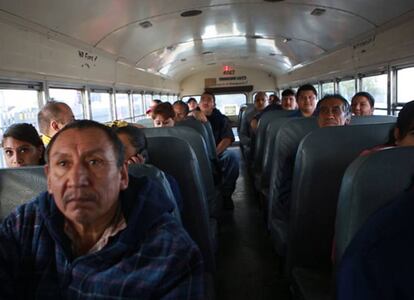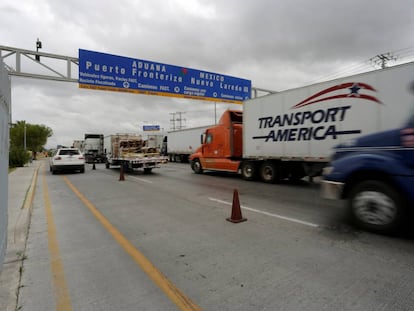Beyond Trump: the hidden threat robots pose to the Mexican economy
Automation endangers model based on low-wage jobs and export of goods made in duty-free zones

For three months now, a completely automated parking lot located on Reforma, one of Mexico City’s main arteries, has been doing the kind of work that would have normally required several dozen human employees. The 700-vehicle facility has been dubbed the largest robotic parking system in North America, and it is a reflection of the times: as technology progresses, more and more jobs run the risk of disappearing.

A similar scene is taking place in the border town of Ciudad Juárez, the heart of Mexico’s low-cost processing and assembly plants located in duty-free zones and known popularly as maquilas. In this labor-intensive sector, robots have also started to take over production processes that until recently required manpower.
Automation poses one of the biggest threats to jobs in the 21st century. But the Mexican case is particularly painful because of its growth model, in which competitive wages play a key role.
This makes the rise of automation technology every bit as much of an economic challenge for Mexico as Donald Trump’s inflammatory trade rhetoric is. Yet, unlike Trump, this issue is not on the public agenda.
Either tech training is provided, or developing countries like Mexico are going to suffer from high unemployment in the future
Javier Acosta, Mechatronics
According to a recent study by global management consultants McKinsey & Company, Mexico ranks seventh in the world when it comes to the percentage of jobs that run the risk of being replaced by machines (52%). This figure rises to 64% in the case of industry, which is one of the country’s major sources of jobs.
And the International Federation of Robotics notes that demand for industrial robots in Mexico grew by 119 percent in 2015, and the trend has just begun.
“Mexico has a higher rate of jobs that are susceptible to being automated than other countries, and that makes the risk of automation at least as significant as the United States’ protectionist turn,” says Mark Muro, a specialist on the digital economy and the impact of technology on growth at The Brookings Institution, a Washington-based think tank. “The expansion of automation will replace the low-cost jobs that are predominant in Mexican industry, and erode its main source of competitive advantage [lower labor costs]. It has already happened in China, and it will happen in Mexico.”
Unlike countries such as China, where labor costs have tended to rise along with the economy and the production of greater aggregate value goods, Mexico has focused on wage competitiveness for the last few decades to attract more investment and prevent manufacturing plants from moving elsewhere.

But robotics places clear limits on that growth model. “At most maquilas, hiring four workers in Mexico is still cheaper that installing a robot in the US. But robotics are getting cheaper, and in many industries such as the auto industry, it is already more profitable to use a robot than to hire teams of workers,” says Tony Payan, director of Mexican studies at the Baker Institute.
Although the percentage of jobs likely to be automated in Brazil (50%) and Argentina (48%) is similar to Mexico’s, the structure of production at the latter country entails an additional risk: it is the only one of Latin America’s large economies that depends more on exports of manufactured goods – where automation has sped up – than on the export of raw materials.
“Betting on manufacturing as a great source of jobs is a strategic mistake these days,” notes Payan.
How long?
One or two decades at the most: that is how long Mexico has to revert the downward jobs trend. “What’s really new about this process of technological change is that it is happening much faster than previous ones,” says Juan Chacaltana, an expert on employment policies at the International Labor Organization (ILO).
So what can Mexican authorities do? All analysts consulted for this story agreed that Mexico should start thinking long term to get out of the loop that the public debate has been trapped in ever since Trump arrived at the White House.
“I see the entire political class as too focused on saving NAFTA. Dealing with automation will be the next administration’s big job: it will face the enormous task of restructuring the economy,” says Payan. “But there is no time to lose.”
Bolstering the domestic market to counter the economy’s reliance on exports is a classic pledge made by every party during campaigns. But with one year to go before federal elections, the specific details of such a move towards economic reorganization remain unclear.
I see the entire political class too focused on saving NAFTA
Tony Payan, Baker Institute
The second reply that analysts gave concerns the issue of education. In a technological change of such scale, there are two simultaneous effects on employment. One is negative: job destruction in favor of automated production processes. The other is positive: higher wages derived from greater productivity.
“The point is to make the second have more weight than the first,” says Chacaltana, of the ILO. “And to do that, worker ability is key.”
“Either tech training is provided, or developing countries like Mexico are going to suffer from high unemployment in the future. And time is running out,” adds Javier Acosta, the top executive at Mechatronics, a Mexican firm that provides state-of-the-art industrial technology.
But so far, the government’s actions have been moving in the opposite direction. Despite early attempts at education reform by the administration of president Enrique Peña Nieto, which were followed by mass protests by the teacher unions, public education suffered the second-largest funding cuts in the 2016 budget – and nearly all of the funds were funneled into teacher salaries.
English version by Susana Urra.
Tu suscripción se está usando en otro dispositivo
¿Quieres añadir otro usuario a tu suscripción?
Si continúas leyendo en este dispositivo, no se podrá leer en el otro.
FlechaTu suscripción se está usando en otro dispositivo y solo puedes acceder a EL PAÍS desde un dispositivo a la vez.
Si quieres compartir tu cuenta, cambia tu suscripción a la modalidad Premium, así podrás añadir otro usuario. Cada uno accederá con su propia cuenta de email, lo que os permitirá personalizar vuestra experiencia en EL PAÍS.
¿Tienes una suscripción de empresa? Accede aquí para contratar más cuentas.
En el caso de no saber quién está usando tu cuenta, te recomendamos cambiar tu contraseña aquí.
Si decides continuar compartiendo tu cuenta, este mensaje se mostrará en tu dispositivo y en el de la otra persona que está usando tu cuenta de forma indefinida, afectando a tu experiencia de lectura. Puedes consultar aquí los términos y condiciones de la suscripción digital.
More information
Archived In
Últimas noticias
A floating school teaches children how to save Lake Atitlán
Pablo Escobar’s hippos: A serious environmental problem, 40 years on
From Andorra to Gibraltar, a black market for Ozempic exploits its success: ‘They’re the most sought-after products in the world’
The brief rise and retreat of Generation Z in Mexico
Most viewed
- Why we lost the habit of sleeping in two segments and how that changed our sense of time
- Charles Dubouloz, mountaineering star, retires at 36 with a farewell tour inspired by Walter Bonatti
- Venezuela faces its most tense Christmas yet
- CBS in crisis after pulling a report on Trump’s deportations to El Salvador (which later leaked online)
- Bukele clan fumes over investigation exposing their new wealth










































